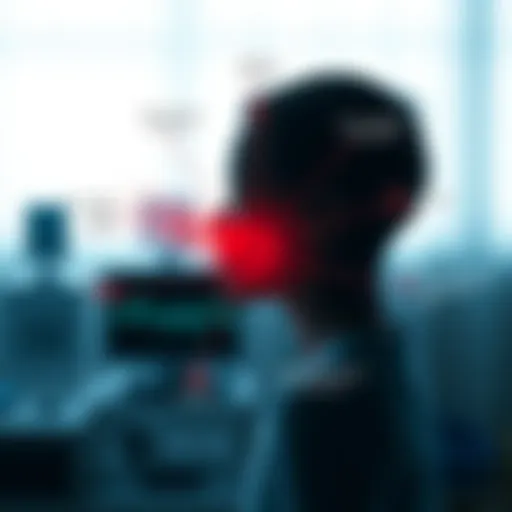Understanding Gallstones After Gallbladder Removal

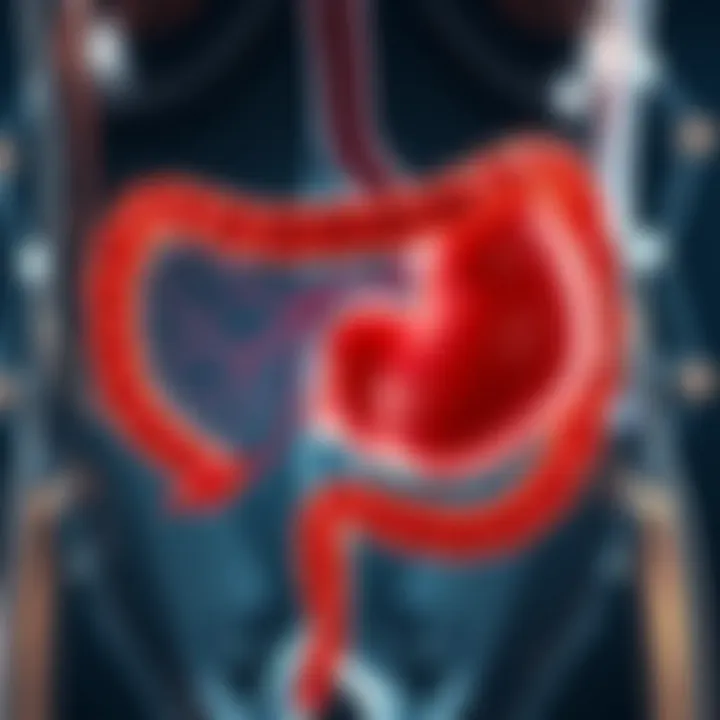
Intro
Gallstones, those small, pebble-like structures, often bring to mind the experience of having a gallbladder. However, what happens when this organ is removed, typically due to the painful and sometimes debilitating effects of gallstones? Contrary to common belief, individuals who have undergone cholecystectomy, or gallbladder removal, may still find themselves grappling with the formation of gallstones. This occurrence might seem perplexing at first. But it unveils a deeper layer of complexity associated with bile production and the body's adaptive mechanisms.
Understanding the nuances of gallstone formation post-cholecystectomy opens up significant avenues of inquiry, touching on aspects of pathology, individual risk factors, and even long-term dietary management. In delving into these areas, one can better appreciate the implications for patient care, treatment protocols, and the overall health strategies that individuals should consider after their gallbladder has been taken out. Not only does this topic command attention, but it also sparks a discussion on ongoing health challenges that patients face long after surgery.
In this exploration, we will provide a clear roadmap to dissect the phenomenon of gallstone formation after gallbladder removal. We will touch upon the critical understanding of how and why this occurs, the implications brought about by diagnostic challenges, and how management practices can be more effectively aligned with patient needs.
This article aims not only to inform but also to engage—laying out the pathophysiology of gallstones as they relate to those who are now gallbladder-free, while emphasizing the importance of continued vigilance in monitoring health post-cholecystectomy. Let's embark on unraveling this unexpected twist in gallbladder health.
Foreword
Understanding the formation of gallstones post-cholecystectomy is a crucial topic in modern medicine. This phenomenon, often overlooked, sheds light on the intricacies of our digestive system even after a significant organ like the gallbladder has been removed. The removal, or cholecystectomy, is typically performed to alleviate pain and prevent complications from gallstones that have already caused distress. However, some patients are left grappling with the unexpected development of gallstones despite the absence of the gallbladder.
For individuals who's undergone cholecystectomy, the perceived freedom from gallstone-related issues can quickly devolve into confusion when they find themselves experiencing similar symptoms again. This article aims to bring clarity to this seemingly paradoxical situation. Here, we will delve into the mechanisms behind the formation of gallstones, the risk factors that may contribute, and the implications for effective diagnosis and management.
Importance of the Topic
Grasping the concept of gallstone formation after gallbladder removal is not just an academic exercise but pivotal for patients and health professionals alike. For patients, having clear knowledge about potential complications allows for greater insights into their health management post-surgery. They can approach follow-up visits more equipped to discuss symptoms and concerns with their care providers, fostering a more proactive health approach.
From a medical perspective, awareness of this condition can guide practitioners in making better-informed decisions regarding patient care, ensuring proper diagnostics, and adapting treatment strategies. This awareness translates into improved outcomes, as it allows for early intervention should gallstones reoccur. Ultimately, the depth of understanding provided by this article serves to empower both patients and healthcare providers in the shared goal of achieving optimal health outcomes.
Overview of the Gallbladder
The gallbladder may appear small—often likened to a thumb-sized pouch—but it plays an invaluable role in our digestive system. Understanding its anatomy and function is pivotal, especially when exploring the implications of its removal and the subsequent phenomena, such as gallstone formation. This concise organ not only aids in digestion, but it also serves as a storage unit for bile, a substance essential for breaking down fats in our diet.
Anatomy and Function
The gallbladder is located neatly beneath the liver, acting as a reservoir. It’s connected to the liver and small intestine via a series of ducts, known as the biliary tree. When food enters the small intestine, a signal prompts the gallbladder to release bile through the cystic duct into the common bile duct, which then delivers it to the duodenum. This process can be thought of as a relay race, where the gallbladder must effectively pass the baton of bile for optimal digestion.
Its walls are muscular, allowing it to contract and expel the stored bile when it’s most needed. However, if the gallbladder is surgically removed—a procedure known as cholecystectomy—this finely tuned network of bile storage and delivery is altered dramatically.
Role in Digestion
In the grand scheme of digestion, the gallbladder holds a critical role. Bile, primarily composed of bile salts, cholesterol, and bilirubin, facilitates fat emulsification, allowing fats to mix better with water. Without the gallbladder, bile continuously drips into the intestine rather than being stored and concentrated.
This shift may lead to changes in the digestive process. Some individuals report alterations in bowel habits, such as diarrhea or difficulty digesting high-fat meals. It's essential to realize that the gallbladder's absence doesn’t mean an end to problematic gallstone formation.
Key Points:
- Storage: Holds bile until release
- Digestion: Aids fat emulsification
- Absence Impact: Continuous bile flow changes digestion
Moreover, while gallstones are commonly associated with the gallbladder, understanding how they can form post-surgery sheds light on the complexities and adaptations of our digestive systems.
Understanding Gallstones
Understanding gallstones is a crucial aspect to explore, particularly post-cholecystectomy. The surgical removal of the gallbladder may seem like a solution to those suffering from gallstone issues, but it does not eliminate the risk of developing gallstones entirely. Knowing how gallstones form and their types can provide vital insights into why some patients may still face discomfort or complications after this procedure.
One of the key elements of the discussion highlights the formation of gallstones themselves. It isn’t merely a matter of pathology; it’s a blend of genetic predispositions, dietary choices, and physiological factors that can lead to gallstone development even after the gallbladder is no longer present. Through this understanding, individuals can better appreciate the importance of maintaining a lifestyle that mitigates these risks.
Furthermore, delving into the types of gallstones—cholesterol, pigment, and mixed—provides clarity on how each type has its own set of characteristics, formation mechanisms, and implications for health. This knowledge is not just academically enriching; it also carries real-life benefits, as individuals can recognize the signs and symptoms associated with different gallstones, ultimately leading to more informed choices about their health.
Formation of Gallstones
Gallstones primarily form when there’s an imbalance in the substances that make up bile, particularly cholesterol and bilirubin. In a healthy gallbladder, bile can dissolve cholesterol. However, when there's too much cholesterol in the bile or if the gallbladder doesn’t empty effectively, crystals can form, which eventually grow into stones. This process isn’t always straightforward, as factors like diet, body weight, and hormonal changes can complicate things.
In post-cholecystectomy cases, the liver continually produces bile, which flows directly into the intestine without storage. This transfer could lead to bile being supersaturated with cholesterol or other substances, increasing the likelihood of gallstones developing rather than preventing them.
Types of Gallstones
Cholesterol Gallstones
Cholesterol gallstones are the most common type found in individuals. They usually appear yellow-green and are primarily made of hardened cholesterol. What sets them apart is the underlying condition of hypercholesterolemia—excessive cholesterol in the bile—which can result from various factors, including diet high in fats and low in fibers.
Interestingly, these gallstones may not cause symptoms immediately, sometimes going unnoticed for years. Yet they have the potential for serious complications, like inflammation or blockage, if they travel into the bile ducts. Their prevalence in the population makes understanding them crucial, especially for those who have had gallbladder surgery.
Pigment Gallstones
In contrast, pigment gallstones are smaller and darker, often made of bilirubin, a byproduct of the breakdown of red blood cells. These are less common but associated with certain medical conditions like liver cirrhosis, biliary tract infections, and hemolytic anemia. The distinct characteristic of pigment stones is their formation in conditions that lead to increased bilirubin levels, resulting in an imbalance.
Awareness of pigment stones is important, particularly for individuals with underlying health issues that could contribute to their formation. They emphasize the role of medical history in understanding post-surgical complications.
Mixed Gallstones
Mixed gallstones comprise both cholesterol and pigment components. They reflect a combination of factors leading to their development, such as metabolic issues, changes in bile concentrations, and infection. As they are the second most common type, their understanding aids in grasping the complexities associated with gallstone formation post-surgery.
The unique feature of mixed gallstones lies in their unpredictable behavior; they can cause symptoms similar to either cholesterol or pigment stones. Such complexities demand attention, as proper diagnosis is vital for managing symptoms effectively.
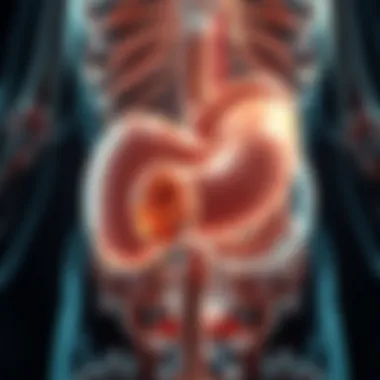
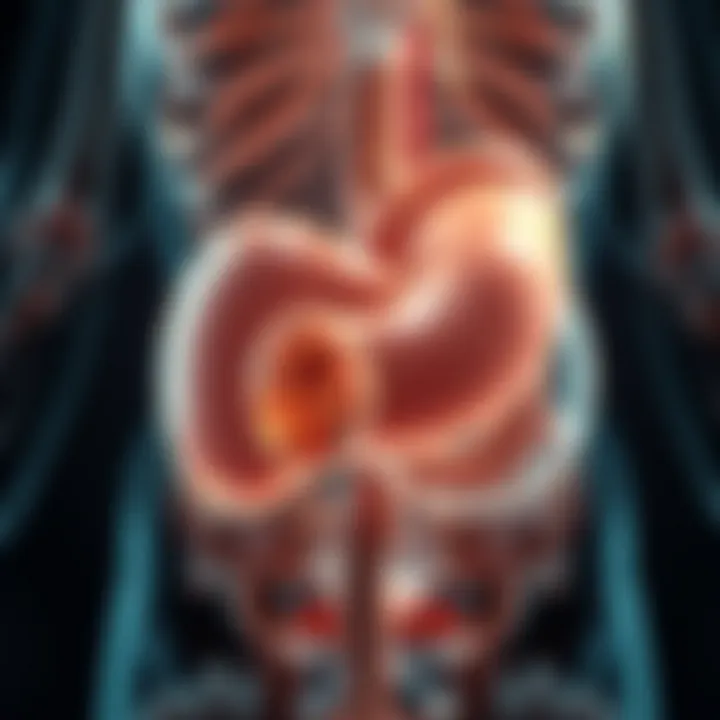
"A nuanced understanding of gallstone types informs not only treatment but also prevention strategies, aiding patients in navigating life after gallbladder removal."
The insights gained from different types of gallstones serve to reinforce the significance of continued vigilance in dietary and health practices, especially for those who have undergone cholecystectomy.
Cholecystectomy: The Gallbladder Removal
Cholecystectomy is the surgical procedure undertaken to remove the gallbladder, a small organ tucked beneath the liver. While this may seem like a simple solution to gallbladder-related issues, it brings about significant changes in the body. The main goal of this surgery is to alleviate symptoms caused by gallstones or other gallbladder diseases. Unquestionably, its significance cannot be overstated, especially when examining the subsequent phenomenon of gallstone formation post-surgery.
Removing the gallbladder can be a double-edged sword. While it relieves immediate discomfort and prevents complications associated with gallstones, it raises questions about how its absence influences bile metabolism and potential gallstone development elsewhere in the bile ducts. Therefore, understanding this procedure is crucial, as it sets the backdrop for examining post-cholecystectomy gallstones, highlighting both immediate benefits and long-term implications.
Indications for Surgery
Cholecystectomy is often necessary for various reasons, chiefly involving gallstones leading to acute or chronic complications. Some key indications for surgery include:
- Cholecystitis: Inflammation of the gallbladder, often due to gallstone obstruction.
- Biliary Colic: Severe pain due to temporary blockage of bile flow.
- Pancreatitis: Inflammation of the pancreas resulting from gallstone obstruction.
- Jaundice: Yellowing of the skin and eyes indicating bile duct obstruction.
These conditions signal that gallbladder removal is essential, as leaving them untreated could lead to severe complications, including infections, perforations, or even increased risks of cancer.
Surgical Techniques
When it comes to surgical approaches, two primary techniques are widely used: laparoscopic and open cholecystectomy.
Laparoscopic Cholecystectomy
Laparoscopic cholecystectomy is a minimally invasive technique where several small incisions are made, allowing the surgeon to use a camera and specialized instruments to remove the gallbladder. This approach offers several advantages:
- Faster Recovery: Patients often experience shorter recovery times compared to open surgery.
- Reduced Scarring: Smaller incisions mean less postoperative scarring, which is favorable for many.
- Less Pain: Generally, patients report experiencing less pain in the postoperative phase.
However, a notable characteristic of laparoscopic cholecystectomy is that it may not be suitable for all patients. For individuals with complicated gallbladder diseases, such as severe inflammation or liver cirrhosis, it might present challenges.
Open Cholecystectomy
In contrast, open cholecystectomy involves a larger incision in the abdominal wall to remove the gallbladder. Although this technique is more traditional, there are times when it is deemed necessary. Key characteristics include:
- Direct Access: It allows for better visualization of the organs, making it a favorable option for complicated cases.
- Handling Complications: Surgeons can directly address any unforeseen complications that may arise during the procedure.
Despite its benefits, open cholecystectomy tends to result in a longer recovery period, along with greater pain and scarring. In many cases, the choice between the two methods depends on the patient's specific condition, overall health, and the surgeon's experience in performing these techniques.
In summary, the method chosen for gallbladder removal can significantly impact the immediate recovery and long-term health outcomes of patients. Understanding these options paves the way for recognizing the implications of gallbladder absence and the potential for developing gallstones post-cholecystectomy.
Can Gallstones Develop Without a Gallbladder?
The topic of gallstones developing post-cholecystectomy stands as a curious feature of human physiology that merits deeper understanding. While most people think that removing the gallbladder eradicates the possibility of gallstones entirely, this isn’t quite the case. The implications of this phenomenon are significant for patients and medical practitioners alike, as it can affect long-term health outcomes, treatment protocols, and dietary recommendations.
After the gallbladder is removed, bile continues to flow from the liver directly into the small intestine. This alteration in bile dynamics can pave the way for gallstone formation in some individuals. Understanding how this occurs is essential for both prevention and management of potential complications.
Mechanisms Behind Formation
The formation of gallstones after gallbladder removal involves a complex interplay of factors. Even without the gallbladder, bile production doesn’t cease; it changes.
- Bile Composition: The composition of bile may remain unchanged, but the regulation of bile salts and cholesterol can be affected. Without the gallbladder's storage capacity, the bile becomes constantly accessible, which changes how it interacts with dietary fats.
- Bile Salt Secretion: The liver continues to secrete bile salts, which are crucial for the emulsification and absorption of fats. However, the lack of a gallbladder means these salts arrive in the intestine in a more diluted state, potentially leading to imbalances that favor stone growth.
- Fat Intake: The body's response to fat intake shifts. A high-fat meal without the gallbladder can lead to inadequate fat digestion and absorption, exacerbating the formation of gallstones through increased bile concentration of cholesterol or bilirubin.
The cumulative effects of these mechanisms could lead to the development of gallstones even in individuals who have undergone a cholecystectomy.
Prevalence and Incidence
The prevalence of gallstones in individuals post-cholecystectomy is noteworthy but not widely known. Statistics indicate that around 10% to 30% of patients may experience gallstone formation after gallbladder removal. While this might seem trivial at first glance, the implications are profound.
- Symptoms: Many individuals may remain asymptomatic, but some can experience abdominal pain, nausea, or even complications such as bile duct obstruction.
- Timeframe: Gallstones can develop months or even years after surgery, which often leads to confusion or misdiagnosis in patients who weren't aware of their increased risks.
- Risk Factors: Factors such as diet, genetic predisposition, and lifestyle choices contribute to this incidence rate. For instance, individuals with higher obesity levels post-surgery face greater risks of stone formation.
Risk Factors for Gallstone Formation After Surgery
Understanding the risk factors for gallstone formation after cholecystectomy is crucial for both medical practitioners and patients. The absence of the gallbladder doesn’t provide a blanket protection against gallstones; in fact, it can sometimes lead to new challenges related to bile metabolism and digestion. Complications can arise when bile salts fail to be adequately managed, leading to stone formation in the bile ducts or remnant gallbladder tissue, if any exists. By identifying and addressing these risk factors, patients and healthcare providers can work collaboratively towards prevention strategies and tailored treatment options.
Dietary Influences
Diet plays a significant role in the likelihood of developing gallstones post-surgery. After a cholecystectomy, the digestive dynamics alter, making diet even more essential. High-fat diets, especially those rich in saturated fats, can exacerbate the risk. Consuming refined sugars and processed foods can also trigger dysregulation of bile composition. Notably, fiber intake is crucial; low fiber diets can impair bowel function and contribute to stone formation. Incorporating healthy fats, like those from avocados and nuts, alongside plenty of fruits and vegetables can maintain bile flow and support overall digestion.
Some specific dietary practices to consider include:
- Reducing saturated fat consumption: This includes avoiding red meats and full-fat dairy products.
- Maintaining hydration: Sufficient water intake helps to dilute bile and prevent crystallization.
- Eating smaller, more frequent meals: This helps to maintain steady bile flow, reducing the risk of stagnation.
"A balanced diet not only nourishes the body but also guides bile in its crucial roles."
Genetic Predispositions
Genetics can silently influence gallstone formation post-cholecystectomy. Certain genetic markers have been linked with predispositions to cholesterol metabolism disorders and bile acid synthesis. If a patient has a family history of gallstones, it may signal a higher risk following surgery. Understanding one’s genetic landscape could provide insights into personalized dietary and lifestyle adjustments to mitigate these risks. A genetic counseling session might also be beneficial for some patients, providing tailored management strategies based on their genetic makeup.
Obesity and Lifestyle Factors
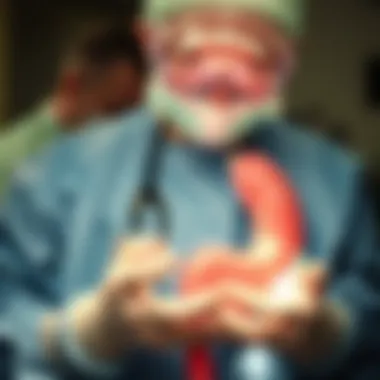
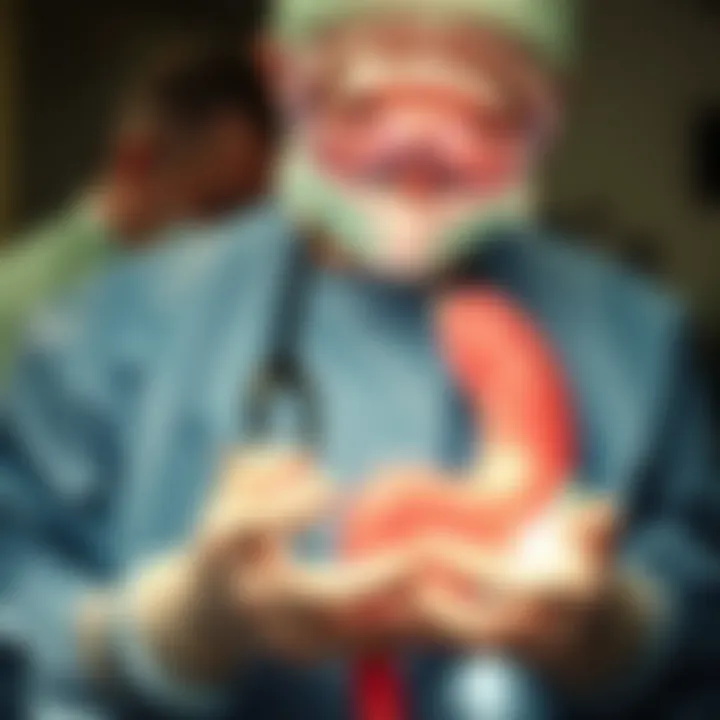
Obesity is an uninvited guest when it comes to gallstone formation. Higher body mass index (BMI) contributes to an increased cholesterol saturation in bile, making stones more likely to develop. It creates an imbalance in bile acids and cholesterol, favoring the formation of gallstones instead of their dissolution. Beyond weight, sedentary lifestyles compound the risk; regular physical activity promotes healthier weight and improved bile metabolism.
To tackle obesity and its related factors:
- Engage in regular physical activity: Aim for at least 150 minutes of moderate exercise weekly.
- Monitor weight: Consistent tracking can promote awareness and healthy changes.
- Seek support: Programs or therapy that focus on nutrition and exercise can be beneficial.
Choosing to adopt a proactive stance towards these lifestyle factors can lead to not just improved health, but a significant reduction in gallstone formation risk post-surgery.
Symptoms and Diagnosis of Gallstones Post-Surgery
Post-cholecystectomy, the emergence of gallstones presents a unique challenge both for patients and medical professionals alike. Symptoms and diagnosis of these gallstones are vital elements in understanding this uncommon phenomenon. Recognizing the signs early can drastically influence treatment decisions and patient outcomes. An accurate diagnosis not only sharpens clinical focus but also empowers patients with knowledge about their health; Apathy around this can lead to complications that might have been avoided.
Clinical Presentation
The clinical presentation of gallstones post-surgery can often catch individuals off-guard, primarily because some may have assumed that gallbladder removal would eradicate all related issues. Symptoms can range from the commonplace to the bafflingly obscure. Typical indicators include:
- Abdominal Pain: Often experienced in the upper right quadrant, this discomfort can mirror the gallbladder-related pain that was previously, an unsettling reminder of past troubles.
- Nausea and Vomiting: These symptoms may reappear after eating, especially following a high-fat meal.
- Digestive Trouble: Patients might report increased bloating, indigestion, or diarrhea.
- Jaundice: A yellowing of the skin or eyes may suggest bile duct obstruction, necessitating prompt medical evaluation.
Recognizing these symptoms early aids in arriving at an informed diagnosis, crucial for exploring treatment options.
Diagnostic Tools
Accurate diagnosis of post-surgical gallstones hinges on effective imaging and diagnostic tools. Various methods are available, each with its own set of characteristics, advantages, and shortcomings.
Ultrasound
Ultrasound is often the first-line imaging technique for suspected gallstones after cholecystectomy. This method stands out due to its non-invasive nature and ability to visualize the biliary system effectively. The key characteristic of ultrasound is its use of sound waves, which create detailed images of internal organs, making it a priceless tool for identifying stones or evaluating bile duct issues.
"Ultrasound provides a safe and effective means of diagnosing biliary complications, likened to a sonic flashlight illuminating the dark recesses of the abdomen."
While ultrasound is beneficial, it does come with certain limitations. It may not always visualize small stones or distinguish between types of stones effectively. Moreover, operator experience can significantly affect the outcomes. Still, its none-invasive approach and ease of access keep it at the forefront of diagnostic options.
CT Scans
CT scans encompass a wider view than ultrasound, capturing detailed cross-sectional images of the abdomen. This method is particularly advantageous for diagnosing complications or alternative conditions that mimic gallstone symptoms. One key characteristic is its exceptional sensitivity in detecting inflammation or blockages in the duct system, crucial for a comprehensive assessment.
However, the use of radiation in CT scans raises potential concerns for some patients. Additionally, the results can be more challenging to interpret compared to ultrasounds. Yet, the benefit of obtaining a detailed, multi-dimensional view of the abdomen keeps CT scans as a key player in the diagnostic landscape.
Endoscopic Techniques
Endoscopic techniques offer a direct approach to the biliary system and can be pivotal in diagnosing and managing post-surgical gallstones. This method allows healthcare providers to visualize and possibly treat stones within the bile duct. A significant strength of endoscopic techniques is their ability to not only diagnose but also intervene, often simultaneously facilitating a more streamlined path to healing.
One unique feature of endoscopic retrograde cholangiopancreatography (ERCP) is its dual function—functioning both as a diagnostic and therapeutic tool. However, such techniques carry risks, including perforation, bleeding, or infection, which can deter their initial use as a diagnostic measure. Still, for certain cases, especially those with suspect duct problems, they can be invaluable.
In summary, the symptoms and diagnosis of gallstones post-cholecystectomy stand as essential components in this discussion. Understanding the clinical presentations combined with targeted diagnostic strategies lays the groundwork for effective management and prevention of future complications.
Management and Treatment Options
Management and treatment options for gallstones formed after cholecystectomy represent a crucial aspect of patient care. Gallstones can be a perplexing issue for individuals who have undergone gallbladder removal. Understanding how to manage these stones is not only essential for symptom relief but also for preventing more severe complications down the line.
The primary objective of treatment should be to alleviate symptoms. Many individuals may not experience any issues post-surgery, but for those who do exhibit signs of discomfort, timely management becomes vital. For example, if a patient reports recurrent abdominal pain or digestive disturbances, an appropriate management strategy can significantly improve their quality of life.
Medical Management
Medical management serves as the initial approach for treating gallstones after cholecystectomy. This typically involves the use of medications designed to dissolve the stones, prevent new ones from forming, and manage symptoms effectively. One common medication used is ursodeoxycholic acid, which can help dissolve certain types of gallstones. However, the success of this treatment can depend on various factors, such as the size and type of stones.
Studies suggest that medical management is often combined with lifestyle modifications to boost effectiveness.
Here are key points regarding medical management:
- Medication: Ursodeoxycholic acid can be beneficial, especially in cases where stones are cholesterol-based.
- Symptom Control: Antacids or medications to manage acid reflux may be prescribed as part of the treatment plan.
- Monitoring: Patients may require regular follow-up appointments to monitor the efficacy of treatment and check for any new stone formation or complications.
While this option may be effective for some, it’s not suitable for everyone. Therefore, personalized treatment plans should be crafted in conjunction with healthcare providers.
Surgical Interventions
When conservative medical management does not yield positive results or when patients experience persistent or severe symptoms, surgical interventions might be considered. Two primary surgical options are available: endoscopic retrograde cholangiopancreatography (ERCP) and laparoscopic procedures.
- ERCP: This is often used when stones become lodged in the bile duct, causing obstruction and significant complications. The procedure can remove these stones non-invasively.
- Laparoscopic Procedures: If stones are recurrent or particularly troublesome, another surgery might be indicated. While not as routine as the first cholecystectomy, laparoscopic techniques can be employed to address additional stones directly, minimizing patient recovery time compared to traditional open surgery.
It’s crucial for patients undergoing any surgical intervention to grasp the potential risks and advantages involved. Surgical options can alleviate symptoms swiftly but shouldn't be taken lightly; recovery can vary widely among individuals based on their overall health and the specifics of the surgery.
In summary, the management of gallstones post-cholecystectomy spans medical management through medication and symptomatic treatment to surgical interventions when necessary. By remaining vigilant and clear about one's symptoms, those affected can work closely with healthcare professionals to maintain better overall health.
Preventive Measures and Lifestyle Adjustments
Preventive measures and lifestyle adjustments play a pivotal role in managing the potential recurrence of gallstones after cholecystectomy. Understanding this aspect is essential for individuals who have undergone gallbladder removal because it provides actionable strategies to minimize risks and enhance well-being. Making informed choices about diet and physical activity can favorably influence bile composition, digestive function, and overall health. It's not just about feeling better; it’s about actively participating in one’s own health journey.
Diet Recommendations
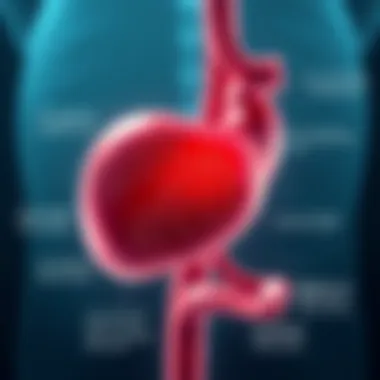
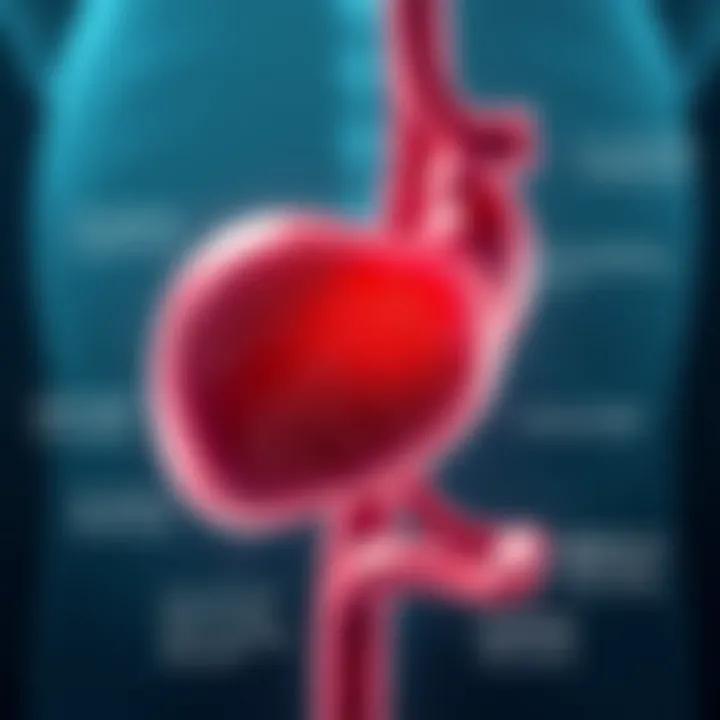
Post-cholecystectomy dietary management is crucial. A well-thought-out diet can significantly mitigate the risk of developing gallstones. The liver continues to produce bile, but without the gallbladder's storage capacity, dietary fat can be met with challenges. Here are some distinct recommendations:
- Opt for Healthy Fats: Embrace unsaturated fats found in foods like avocados, nuts, and olive oil while steering clear of saturated fats. For instance, choose grilled salmon instead of fried fish, which can lead to digestive troubles.
- Increase Fiber Intake: Foods rich in fiber, such as whole grains, fruits, and vegetables, help improve digestion and promote regular bowel movements. Think about incorporating oats for breakfast or snacking on apple slices with almond butter.
- Stay Hydrated: Water is a simple yet effective ally. Adequate hydration helps maintain bile consistency and aids digestion. Carrying a reusable water bottle could be a gentle reminder to sip throughout the day.
- Eat Smaller, Frequent Meals: Instead of three large meals a day, consuming smaller meals more often can ease the digestive process and promote efficient bile use. Aiming for six small meals can reduce the strain on your system.
- Limit Processed Foods: Reducing intake of processed foods, sugars, and refined carbohydrates can lessen bile sludge formation. For example, swapping white bread for whole-grain alternatives can make a world of difference to your digestive health.
A mindful approach to eating is not merely a fad. It's a lifestyle shift that resonates with our bodies’ needs post-surgery.
Implementing these dietary strategies may be challenging, but they present an opportunity for those who have had their gallbladder removed to actively engage in their dietary decisions. It’s all about balance, moderation, and giving preference to healthful options.
Physical Activity Guidelines
Regular physical activity constitutes another cornerstone of preventive care after gallbladder surgery. It does not need to be overly strenuous; rather, consistency often outweighs intensity. Here are some guidelines:
- Aim for at least 150 Minutes of Moderate Exercise Weekly: Activities such as brisk walking, jogging, or cycling can promote liver function, facilitate digestion, and maintain a healthy weight. Find a local park to walk with friends a few times a week.
- Incorporate Strength Training: Engaging in strength training exercises twice a week can help boost metabolism and support overall body function. Simple exercises such as bodyweight squats or resistance bands can be effective.
- Listen to Your Body: Post-surgery, it's essential to pay attention to how your body responds to different types of activities. Gradually introduce exercise into your routine and adjust as necessary. If jogs leave you feeling fatigued, perhaps a gentle yoga session might be better.
- Stay Active During Daily Activities: Small changes can add up. Take the stairs instead of the elevator, or choose to walk instead of driving short distances. These adjustments help to keep you active without needing to carve out extra time for workouts.
- Focus on Flexibility: Stretching exercises should not be neglected. They help maintain joint health and can alleviate any tension that arises from post-operative physical changes.
Engaging in regular physical activity isn't just about cardiovascular health; it's about improving your quality of life overall.
In summary, thoughtful dietary and physical lifestyle adjustments not only help in preventing gallstone formation post-cholecystectomy but actively enhance one’s quality of life. While these changes require commitment, the rewards can be substantial, allowing individuals to better manage their health and live vibrantly after gallbladder removal.
Long-term Implications of Gallbladder Removal
The removal of the gallbladder, known as cholecystectomy, can lead to several long-term implications for patients. While many people may recover fully and live without the gallbladder with little to no ongoing issues, it is important to understand that this procedure affects digestion and can lead to some complications, particularly the development of gallstones post-surgery. Addressing the long-term effects is not only crucial for the understanding of the medical community but also for the patients themselves, as they may navigate a new landscape of health post-operation.
Digestive Changes
After gallbladder removal, patients often experience significant changes in their digestion. One of the primary roles of the gallbladder is to store bile until it's needed for digestion; hence, a lack of this organ means that bile flows constantly into the intestine, rather than being released in spurts. This continuous release can impact the digestion of fats, which may lead some individuals to experience diarrhea or bloating after consuming fatty foods.
For some, adjustments in diet may become essential. What once was a straightforward meal may now demand careful consideration. Here are some insights into the digestion changes:
- Fat Malabsorption: With the absence of the gallbladder, higher-fat meals might become less tolerable, causing symptoms such as greasy stools or abdominal discomfort.
- Constipation or Diarrhea: Fluctuations in bowel habits can occur, leading to episodes of diarrhea or difficulty with regularity after eating. Some patients adjust well, but for others, it may become a burden.
- Nutritional Deficiencies: A lack of bile may inhibit proper absorption of fat-soluble vitamins such as A, D, E, and K, leaving individuals at risk for deficiencies. Therefore, monitoring one’s nutrition becomes crucial.
Overall, these digestive changes can have far-reaching consequences on a patient's daily routine and quality of life. Understanding these shifts is vital, as they guide individuals in taking proactive steps to manage their diet and health.
Gallstone Recurrence Rates
While it may seem paradoxical to develop gallstones without a gallbladder, it is indeed a possibility, and understanding the recurrence rate of gallstones post-cholecystectomy is essential. Research indicates that while rates of new gallstone formation after cholecystectomy are generally low, they are not zero. Factors influencing this occurrence include:
- Bile Composition: With the gallbladder gone, bile can become supersaturated, which can foster gallstone formation.
- Dietary Choices: A high-fat or high-cholesterol diet can influence stone development.
- Metabolic Disorders: Patients with conditions like diabetes or obesity are at a higher risk for gallstones later in life.
It’s estimated that the recurrence rate of gallstones can be between 5% to 15% of patients years post-surgery. Three key types of new gallstones can develop:
- Cholesterol Gallstones: These are the most common type, often linked to diet and body weight.
- Pigment Gallstones: These are usually smaller and darker and can occur due to liver disease.
- Mixed Gallstones: These contain a combination of both cholesterol and pigment stones.
Understanding these stones' nature can help both patients and healthcare providers develop better prevention strategies. Keeping tabs on dietary habits can reduce the risks significantly, and adopting a proactive approach can prevent a return to the operating table.
"A proactive approach to diet and lifestyle can make all the difference after gallbladder surgery."
In summary, the long-term implications of gallbladder removal necessitate a comprehensive understanding to ensure that patients can manage and mitigate any potential issues that may arise in their post-surgical lives.
End
In summarizing the intricate topic surrounding gallstone formation post-cholecystectomy, it's crucial to highlight the profound impacts this phenomenon can have on individuals after gallbladder removal. Many patients believe that once the gallbladder is gone, they are free from the possibility of gallstones. However, as delineated throughout this article, this misconception needs addressing.
Importance of Understanding This Condition
The significance of understanding gallstones that may form after cholecystectomy cannot be overstated. This knowledge equips patients and healthcare professionals alike with the tools needed to identify symptoms early and manage any potential complications. Not only does this facilitate timely intervention, but it also contributes to a broader awareness regarding post-operative health and wellness.
Key Elements to Consider
- Pathophysiology: Recognizing the mechanisms behind the formation of gallstones after gallbladder removal is essential. Patients must understand how bile metabolism can lead to stone formation, despite a lack of the organ traditionally responsible for storing bile.
- Lifestyle Factors: Emphasis on the importance of maintaining a balanced diet and healthy lifestyle choices post-surgery is critical. Educating individuals on how to navigate those changes can mitigate the risks of stone recurrence.
- Diagnostic Challenges: Understanding the nuances behind diagnosis can significantly affect outcomes. Knowing which diagnostic tools—such as ultrasound or CT scans—are more effective can make a world of difference in timely detection.
Benefits of a Comprehensive Approach
Adopting a thorough understanding and approach not only enhances patient experiences but also fosters better healthcare providers’ practices. Engaging with this knowledge facilitates a dialogue between patients and physicians, ensuring that follow-up care is tailored to minimize long-term complications associated with gallstones.
Ultimately, by exploring the layers of gallstone formation post-cholecystectomy, we enable those concerned to take proactive measures in their health journey. It's a reminder that while removal of the gallbladder is a significant procedure, the journey toward comprehensive health doesn't end with the surgery; indeed, it is just the beginning.
Importance of References in This Article
In a realm where medical misinformation can lead to serious consequences, the significance of accurate references cannot be overstated. These references illuminate key aspects such as:
- Support for Clinical Claims: Each claim backed by scientific literature enhances credibility, fostering trust. For instance, referencing studies published in renowned medical journals allows readers to explore the original research behind the assertions made in this piece.
- Broader Context: References help readers see the bigger picture. They can delve into how the topic fits into broader medical discussions, including preventative strategies or advancements in surgical techniques.
- Updates on Current Research: The medical field is ever-evolving, and having access to recent studies is vital. Readers can stay updated on new findings about gallstone management and prevention long after the publication of this article.
Specific Elements to Consider
The choice of references is not merely about quantity; it's about quality and relevance. Important considerations include:
- Peer-Reviewed Journals: Always look to include studies from peer-reviewed platforms, such as The New England Journal of Medicine or Gut, as these sources have undergone rigorous scrutiny.
- Guidelines from Professional Associations: Resources such as the American College of Gastroenterology or the European Association for the Study of the Liver contribute essential guidelines for clinical practices.
- Authoritative Medical Websites: Reliable sites like Mayo Clinic and WebMD offer insights that can be helpful for readers seeking general understanding without getting lost in academic jargon.
Effective understanding often hinges on well-cited work, so it pays to ensure references are diverse and trustworthy.
Benefit of High-Quality References
Using well-cited resources lessens the likelihood of sharing outdated or inaccurate information. This commitment results in:
- Enhanced Readability: Well-researched content is generally more coherent and easier to digest.
- Educational Value: A wealth of references supports those who may wish to pursue further research or education on gallstones and digestive health post-cholecystectomy.
- Trust and Reliability: In academic writing, credibility is king. Well-chosen references anchor the arguments presented and underscore the dedication to factual accuracy.













